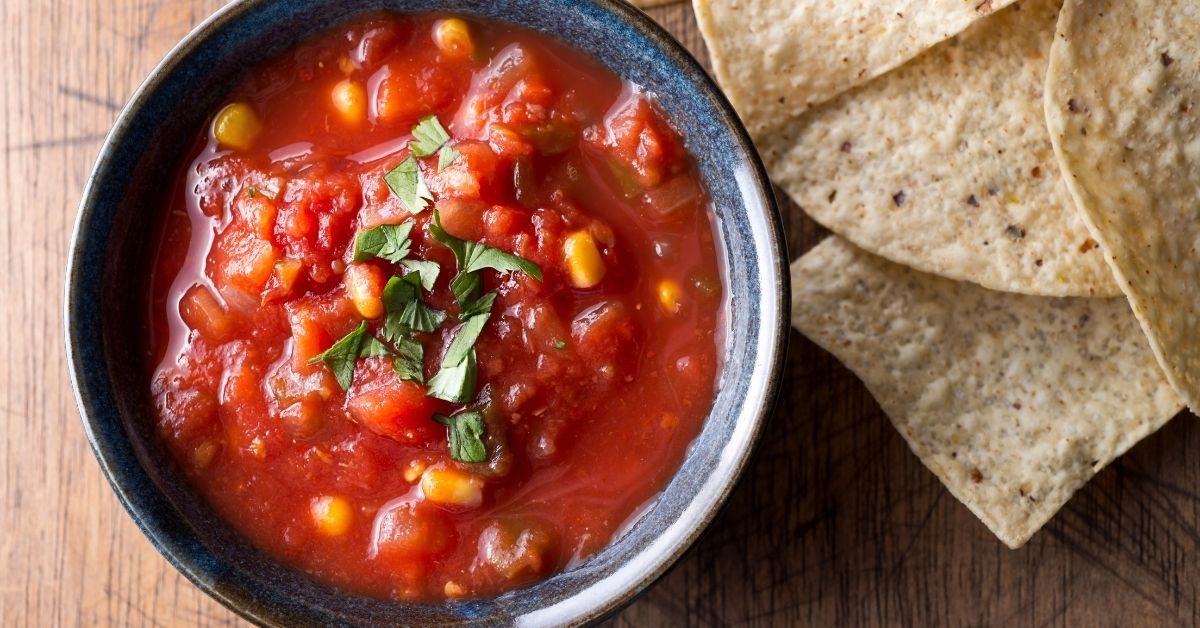How to Fix Watery Salsa? 5 Fresh Ways

If you are a lover of Mexican cuisine, just like me, you probably usually cook salsa in the pico de gallo style to have the best tacos. As the days will pass, for specific reasons, this sauce may get watery and not in the proper composition anymore. Still, it does not mean that you cannot consume it or make it thick again. So, how to fix watery salsa, and what are the ways to thicken it?
The best way to thicken salsa is to add some components, starting with the elements already in the salsa like pepper, onion, and jalapeno. Or, you can add spicy peppers to make a salsa piquant. Another way you can modify your recipe is by adding some tropical flavor through mango or avocado.
But how to do it, and how will the final product come out? Is it better this way with fresh ingredients or with thickeners? Swipe below to read for all tips on preventing the salsa from getting watery in the first place.
How to Thicken Watery Salsa?
If, at some point, for reasons I have explained below, your salsa will be thin with a lot of extra water, there are always some ways to bring it back to the game and make it delicious again. So let’s see them together.
Similar steps can be applied if you want to thicken your salsa verde.
Add More Ingredients
A preferable way for me would be to do it organically and healthily. You can do this by adding in the sauce more of the ingredients that are already there: a little onion, garlic, jalapeno, or cilantro. Those solid ingredients will absorb all the extra juice and water and make the sauce composition good again, so you can still consume it for some additional days.

Redesign Your Sauce
In the same philosophy as above, you can decide to add some different vegetables or fruits that may change the taste of the sauce a little, but it can add other flavors that will taste equally delicious, just different. One possible option is to add bell peppers and spicy peppers to the Mexican concept. In this case, from a typical fresh Pico de Gallo sauce, it will convert it into the devil’s sauce. But, if you love piquant, you won’t complain.
Another scenario utterly different from the spicy one would be to recreate a more exotic sauce by adding mango, avocado, or cucumber. Each of those ingredients will uniquely change the dressing. If you go for mango, it will make it sweeter, while my favorite, avocado, will make it creamer and increase the sauce’s fat content. And cucumber will for sure add to the plait a fresher and softer taste.
Add Greek Yogurt
A tablespoon of fresh greek yogurt or even creme fraiche can also work perfectly in this new sauce, as it’s a light yogurt that combines perfectly with all other ingredients mixed there. So, in the end, it will be creamy yet fresh, cold, and ready to dip there everything from taco chips to falafel or chicken nuggets.
Add Cornstarch
The most simple way that works every time is adding cornstarch in the Salsa. Even so, you cannot add cornstarch directly to the salsa. You need to boil the salsa with cornstarch and a little water to fix your consistency. After some minutes, you will obtain the desired texture again.
Experiment on your own
Okay, maybe you don’t expect this answer, but it’s true. Tastes are so personal, and what tastes fantastic for you, perhaps it’s not that delicious for other people, but this does not mean it’s not worth eating, especially if it makes you happy.
Culinary is endless, so you can experiment according to your preferences to add extra ingredients that will make it thicker and influence the taste in a good way. You like pickles, beans, or quinoa. Try to put it in and see the result. If all ingredients are fresh, for sure something nice will come up.
Why Is Your Salsa Too Watery and How to Fix Watery Salsa?
The main ingredients that have a larger quantity in this recipe are tomatoes. However, as a product containing a considerable water quantity of approximately 95%, tomatoes are the primary source of juiciness in the recipe. Therefore, what you can do to minimize the risk is choose less watery tomatoes.
As consumers, we intend to go to the soft tomatoes, as we percept that juicy and soft tomatoes will be fresher and sweeter. In this case, you need to choose the most solid tomatoes. One of the known varieties for this occasion is Roma tomatoes. If for any reason you cannot find it in the market, you can go for each other variety, but the young tomatoes.
Another reason why the composition of your salsa may be too watery is the technique of blending. Thinking that the result will be better this way, most people blend in an electronic mixer all the ingredients. But, in fact, even why will take more time, it’s better to cut the tomatoes with a knife.
The blender will cut them and squeeze and drain all the juice of the tomatoes, no matter how dry they may be. Of course, you can always blend all other ingredients, and when coming to tomatoes, you may add them in the end and mix with a spoon. But even in the case of different components, don’t thoroughly blend them. This sauce is not the creamy type, and it’s needed to feel the pieces in your mouth.
A possible way if you still don’t have the time or the desire to cut them by hand is to blend and use a colander to get all the water away and keep only the pieces of tomatoes and the pure. After mixing with other ingredients, you can decide which juice you reuse to obtain the desired consistency.
And the last tip to prevent the undesired moisture on your Salsa, I would suggest removing the tomato seeds. But, again, this is a small detail that even why it sometimes affects the consistency of the sauce more than you think as the seeds influence the water content.
Can You Boil Salsa to Thicken?
The technique of boiling salsa works, and I would propose it under some circumstances. Mixing all ingredients can be boiled in a saucepan, and due to heat, all the water in the salsa will evaporate to get a thick mass.
The most common and classic way to fix all types of sauces is to add a thickener to the sauce, for example, cornstarch. For each cup of dressing, you need to add a tablespoon of cornstarch or more if you want it very thick.
To do that, you will need to boil the sauce in a saucepan and whisk it with cornstarch until the cornstarch is mixed with the sauce. In this case, you will obtain a hot and cooked sauce in the end.
Can You Thicken Canned Salsa?
It depends on the type of salsa you have chosen to use. It is a little hard to give a valid response for all kinds of canned salsas you can find out there. However, I may say that the boiling method will work in almost any salsa.
If you boil it, all the water will evaporate, and you will have a more thick and dry salsa. Also, the cornstarch method, for sure, will work, as it’s a thickener that can work with almost every juicy mixing.
How Long to Cook Salsa?
This is the best part, as this fantastic recipe requires a minimum of effort and time. I would say that you will spend a maximum of 15 to 27 minutes in salsa. All the preparation from cleaning, pealing, and cutting the ingredient such as cilantro, red and green onion, garlic, and jalapeno will take a maximum of 10 minutes.
If you decide to chop the tomatoes by yourself, it may take you an extra 10 minutes. And in the end, all the bleeding and the last adjustments will not take more than 7 minutes. So in less than 30 minutes, you will have this Mexican beauty ready. Of course, you can still let it rest for less than half-hour in the fridge, and then you can consume it.
Can You Use Tomato Paste to Thicken Salsa?
You can do it, although it’s not the best option ever. And why? Because homemade salsa is made of fresh ingredients with low acidity, and tomato paste you find in supermarkets usually has a high acidic content. To use tomato paste in this salsa, you have to be careful with the ratios you will use of both Salsa and Paste.
Try to find a supreme quality tomato sauce that is natural or organic. It is enough, just a tablespoon of the sauce mixed with the salsa. Even here, we have two possibilities: If the sauce is delicious and not very acidic, you can just mix it and eat it like that, but if the sauce is acidic and contains concentrates, the best option would be to boil it for some minutes.
How Do You Know If Salsa Has Gone Bad?
Despite our goodwill not to waste the salsa and to use all mentioned tips and advice to make it better and to eat it again, there is a moment that you cannot do anything. The homemade salsa’s shelf-life is undoubtedly shorter than the industrial one due to the lack of additives that intend to extend it. It can resist in your fridge for up to 5 days.
After that, it may start showing the first signs of rotting. The vegetables and fruits included will begin to lose their freshness, the color will be affected, and you will know it. Learn to trust yourself, and it does not mean to see the mold; it means the sauce is going bad.
Sometimes it can still not be dangerous to be eaten, but it will destroy your eating experience. So, at this point, I support the theory that you better throw it away rather than force yourself to refix it. So, with your instincts and experience, you will know when to let it go.
